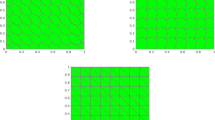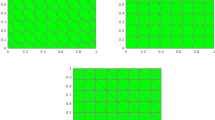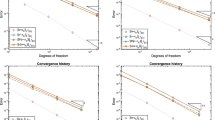Abstract
We present a priori and superconvergence error estimates of mixed finite element methods for the pseudostress-velocity formulation of the Oseen equation. In particular, we derive superconvergence estimates for the velocity and a priori error estimates under unstructured grids, and obtain superconvergence results for the pseudostress under certain structured grids. A variety of numerical experiments validate the theoretical results and illustrate the effectiveness of the superconvergent recovery-based adaptive mesh refinement. It is also numerically shown that the proposed postprocessing yields apparent superconvergence in a benchmark problem for the incompressible Navier–Stokes equation.






Similar content being viewed by others
Data Availability
Data sharing is not applicable to this article as no datasets were generated or analysed during the current study.
Code Availability Statement
The code used in this study is available from the authors upon request.
References
Acosta, G., Apel, T., Durán, R.G., Lombardi, A.L.: Error estimates for Raviart-Thomas interpolation of any order on anisotropic tetrahedra. Math. Comp. 80(273), 141–163 (2011). https://doi.org/10.1090/S0025-5718-2010-02406-8
Antonietti, P.F., Beirão da Veiga, L., Mora, D., Verani, M.: A stream virtual element formulation of the Stokes problem on polygonal meshes. SIAM J. Numer. Anal. 52(1), 386–404 (2014). https://doi.org/10.1137/13091141X
Apel, T., Kempf, V.: Brezzi-Douglas-Marini interpolation of any order on anisotropic triangles and tetrahedra. SIAM J. Numer. Anal. 58(3), 1696–1718 (2020). https://doi.org/10.1137/19M1302910
Arnold, D.N., Douglas, J., Jr., Gupta, C.P.: A family of higher order mixed finite element methods for plane elasticity. Numer. Math. 45(1), 1–22 (1984). https://doi.org/10.1007/BF01379659
Arnold, D.N., Falk, R.S., Winther, R.: Finite element exterior calculus, homological techniques, and applications. Acta Numer. 15, 1–155 (2006). https://doi.org/10.1017/S0962492906210018
Arnold, D.N., Falk, R.S., Winther, R.: Finite element exterior calculus: from Hodge theory to numerical stability. Bull. Am. Math. Soc. 47(2), 281–354 (2010). https://doi.org/10.1090/S0273-0979-10-01278-4
Arnold, D.N., Li, L.: Finite element exterior calculus with lower-order terms. Math. Comp. 86(307), 2193–2212 (2017). https://doi.org/10.1090/mcom/3158
Babuška, I., Rheinboldt, W.C.: Error estimates for adaptive finite element computations. SIAM J. Numer. Anal. 15(4), 736–754 (1978). https://doi.org/10.1137/0715049
Bank, R.E., Li, Y.: Superconvergent recovery of Raviart-Thomas mixed finite elements on triangular grids. J. Sci. Comput. 81(3), 1882–1905 (2019). https://doi.org/10.1007/s10915-019-01068-0
Bank, R.E., Xu, J.: Asymptotically exact a posteriori error estimators: I: grids with superconvergence. SIAM J. Numer. Anal. 41(6), 2294–2312 (2003). https://doi.org/10.1137/S003614290139874X
Barrios, T.P., Cascón, J.M., González, M.: Augmented mixed finite element method for the Oseen problem: a priori and a posteriori error analyses. Comput. Methods Appl. Mech. Engrg. 313, 216–238 (2017). https://doi.org/10.1016/j.cma.2016.09.012
Barrios, T.P., Cascón, J.M., González, M.: On an adaptive stabilized mixed finite element method for the Oseen problem with mixed boundary conditions. Comput. Methods Appl. Mech. Eng. (2020). https://doi.org/10.1016/j.cma.2020.113007
Behr, M.A., Franca, L.P., Tezduyar, T.E.: Stabilized finite element methods for the velocity-pressure-stress formulation of incompressible flows. Comput. Methods Appl. Mech. Eng. 104(1), 31–48 (1993). https://doi.org/10.1016/0045-7825(93)90205-C
Boffi, D., Brezzi, F., Fortin, M.: Mixed finite element methods and applications. In: Springer Series in Computational Mathematics. Springer, Heidelberg (2013)
Bramble, J.H., Xu, J.: A local post-processing technique for improving the accuracy in mixed finite-element approximations. SIAM J. Numer. Anal. 26(6), 1267–1275 (1989). https://doi.org/10.1137/0726073
Brandts, J.H.: Superconvergence and a posteriori error estimation for triangular mixed finite elements. Numer. Math. 68(3), 311–324 (1994). https://doi.org/10.1007/s002110050064
Brandts, J.H.: Superconvergence for triangular order \(k=1\) Raviart-Thomas mixed finite elements and for triangular standard quadratic finite element methods. Appl. Numer. Math. 34(1), 39–58 (2000). https://doi.org/10.1016/S0168-9274(99)00034-3
Brezzi, F., Douglas, J., Jr., Durán, R., Fortin, M.: Mixed finite elements for second order elliptic problems in three variables. Numer. Math. 51(2), 237–250 (1987). https://doi.org/10.1007/BF01396752
Brezzi, F., Douglas, J., Jr., Fortin, M., Marini, L.D.: Efficient rectangular mixed finite elements in two and three space variables. RAIRO Modél. Math. Anal. Numér. 21(4), 581–604 (1987). https://doi.org/10.1051/m2an/1987210405811
Brezzi, F., Douglas, J., Jr., Marini, L.D.: Two families of mixed finite elements for second order elliptic problems. Numer. Math. 2(47), 217–235 (1985)
Cáceres, E., Gatica, G.N.: A mixed virtual element method for the pseudostress-velocity formulation of the Stokes problem. IMA J. Numer. Anal. 37(1), 296–331 (2017). https://doi.org/10.1093/imanum/drw002
Cáceres, E., Gatica, G.N., Sequeira, F.A.: A mixed virtual element method for the Brinkman problem. Math. Models Methods Appl. Sci. 27(4), 707–743 (2017). https://doi.org/10.1142/S0218202517500142
Cai, Z., Tong, C., Vassilevski, P.S., Wang, C.: Mixed finite element methods for incompressible flow: stationary Stokes equations. Numer. Methods Partial Differ. Equ. 26(4), 957–978 (2010). https://doi.org/10.1002/num.20467
Cai, Z., Wang, C., Zhang, S.: Mixed finite element methods for incompressible flow: stationary Navier-Stokes equations. SIAM J. Numer. Anal. 48(1), 79–94 (2010). https://doi.org/10.1137/080718413
Cai, Z., Wang, Y.: A multigrid method for the pseudostress formulation of Stokes problems. SIAM J. Sci. Comput. 29(5), 2078–2095 (2007). https://doi.org/10.1137/060661429
Cai, Z., Zhang, S.: Mixed methods for stationary Navier-Stokes equations based on pseudostress-pressure-velocity formulation. Math. Comput. 81(280), 1903–1927 (2012). https://doi.org/10.1090/S0025-5718-2012-02585-3
Carrero, J., Cockburn, B., Schötzau, D.: Hybridized globally divergence-free LDG methods: I: the Stokes problem. Math. Comput. 75(254), 533–563 (2006). https://doi.org/10.1090/S0025-5718-05-01804-1
Carstensen, C., Gallistl, D., Schedensack, M.: Quasi-optimal adaptive pseudostress approximation of the Stokes equations. SIAM J. Numer. Anal. 51(3), 1715–1734 (2013)
Carstensen, C., Kim, D., Park, E.J.: A priori and a posteriori pseudostress-velocity mixed finite element error analysis for the Stokes problem. SIAM J. Numer. Anal. 49(6), 2501–2523 (2011)
Cesmelioglu, A., Cockburn, B., Nguyen, N.C., Peraire, J.: Analysis of HDG methods for Oseen equations. J. Sci. Comput. 55(2), 392–431 (2013). https://doi.org/10.1007/s10915-012-9639-y
Cesmelioglu, A., Cockburn, B., Qiu, W.: Analysis of a hybridizable discontinuous Galerkin method for the steady-state incompressible Navier-Stokes equations. Math. Comp. 86(306), 1643–1670 (2017). https://doi.org/10.1090/mcom/3195
Chen, X., Li, Y., Drapaca, C., Cimbala, J.: A unified framework of continuous and discontinuous Galerkin methods for solving the incompressible Navier-Stokes equation. J. Comp. Phys. (2020). https://doi.org/10.1016/j.jcp.2020.109799
Christiansen, S.H., Winther, R.: Smoothed projections in finite element exterior calculus. Math. Comput. 77(262), 813–829 (2008)
Cockburn, B., Sayas, F.J.: Divergence-conforming HDG methods for Stokes flows. Math. Comput. 83(288), 1571–1598 (2014). https://doi.org/10.1090/S0025-5718-2014-02802-0
Cui, M., Ye, X.: Superconvergence of finite volume methods for the Stokes equations. Numer. Methods Partial Differ. Equ. 25(5), 1212–1230 (2009). https://doi.org/10.1002/num.20399
Demlow, A.: Suboptimal and optimal convergence in mixed finite element methods. SIAM J. Numer. Anal. 39(6), 1938–1953 (2002). https://doi.org/10.1137/S0036142900376900
Di Pietro, D.A., Ern, A.: Mathematical aspects of discontinuous Galerkin methods, Mathématiques & Applications (Berlin) [Mathematics & Applications], Springer, Heidelberg (2012). https://doi.org/10.1007/978-3-642-22980-0
Dörfler, W.: A convergent adaptive algorithm for Poisson’s equation. SIAM J. Numer. Anal. 33(3), 1106–1124 (1996). https://doi.org/10.1137/0733054
Douglas, J., Jr., Roberts, J.E.: Global estimates for mixed methods for second order elliptic equations. Math. Comput. 44(169), 39–52 (1985). https://doi.org/10.2307/2007791
Durán, R.: Superconvergence for rectangular mixed finite elements. Numer. Math. 58(3), 287–298 (1990). https://doi.org/10.1007/BF01385626
Egger, H., Schöberl, J.: A hybrid mixed discontinuous Galerkin finite-element method for convection-diffusion problems. IMA J. Numer. Anal. 30(4), 1206–1234 (2010). https://doi.org/10.1093/imanum/drn083
Eichel, H., Tobiska, L., Xie, H.: Supercloseness and superconvergence of stabilized low-order finite element discretizations of the Stokes problem. Math. Comput. 80(274), 697–722 (2011). https://doi.org/10.1090/S0025-5718-2010-02404-4
Ewing, R.E., Liu, M.M., Wang, J.: Superconvergence of mixed finite element approximations over quadrilaterals. SIAM J. Numer. Anal. 36(3), 772–787 (1999)
Falk, R.S., Neilan, M.: Stokes complexes and the construction of stable finite elements with pointwise mass conservation. SIAM J. Numer. Anal. 51(2), 1308–1326 (2013). https://doi.org/10.1137/120888132
Farhloul, M., Fortin, M.: A new mixed finite element for the Stokes and elasticity problems. SIAM J. Numer. Anal. 30(4), 971–990 (1993). https://doi.org/10.1137/0730051
Fu, G., Jin, Y., Qiu, W.: Parameter-free superconvergent \(H({\rm div})\)-conforming HDG methods for the Brinkman equations. IMA J. Numer. Anal. 39(2), 957–982 (2019). https://doi.org/10.1093/imanum/dry001
Gatica, G.N., Gatica, L.F., Márquez, A.: Analysis of a pseudostress-based mixed finite element method for the Brinkman model of porous media flow. Numer. Math. 126(4), 635–677 (2014). https://doi.org/10.1007/s00211-013-0577-x
Gatica, G.N., González, M., Meddahi, S.: A low-order mixed finite element method for a class of quasi-Newtonian Stokes flows: I: a priori error analysis. Comput. Methods Appl. Mech. Eng. 193(911), 881–892 (2004). https://doi.org/10.1016/j.cma.2003.11.007
Girault, V., Raviart, P.A.: Finite element methods for Navier-Stokes equations. Springer Series in Computational Mathematics. Springer-Verlag, Berlin (1986). https://doi.org/10.1007/978-3-642-61623-5. Theory and algorithms
Guzmán, J., Neilan, M.: Conforming and divergence-free Stokes elements on general triangular meshes. Math. Comput. 83(285), 15–36 (2014). https://doi.org/10.1090/S0025-5718-2013-02753-6
Hu, J., Ma, L., Ma, R.: Optimal superconvergence analysis for the Crouzeix-Raviart and the Morley elements. Adv. Comput. Math. (2021). https://doi.org/10.1007/s10444-021-09874-7
Hu, J., Yu, G.: A unified analysis of quasi-optimal convergence for adaptive mixed finite element methods. SIAM J. Numer. Anal. 56(1), 296–316 (2018)
Huang, Y., Li, J., Wu, C.: Averaging for superconvergence: verification and application of 2d edge elements to maxwell’s equations in metamaterials. Comput. Methods Appl. Mech. Engrg. 255, 121–132 (2013)
Kundu, P.K., Dowling, D.R., Tryggvason, G., Cohen, I.M.: Fluid Mechanics. Academic Press, Cambridge (2015)
Li, Y.: Quasi-optimal adaptive mixed finite element methods for controlling natural norm errors. Math. Comput. 90(328), 565–593 (2021). https://doi.org/10.1090/mcom/3590
Li, Y.: Superconvergent flux recovery of the Rannacher-Turek nonconforming element. J. Sci. Comput. (2021). https://doi.org/10.1007/s10915-021-01445-8
Li, Y., Zikatanov, L.: New stabilized \({P}_1\times {P}_0\) finite element methods for nearly inviscid and incompressible flows. arXiv preprint arXiv:2109.04013 (2021)
Li, Y.W.: Global superconvergence of the lowest-order mixed finite element on mildly structured meshes. SIAM J. Numer. Anal. 56(2), 792–815 (2018). https://doi.org/10.1137/17M112587X
Liu, H., Yan, N.: Superconvergence analysis of the nonconforming quadrilateral linear-constant scheme for Stokes equations. Adv. Comput. Math. 29(4), 375–392 (2008). https://doi.org/10.1007/s10444-007-9054-3
Liu, J.: Open and traction boundary conditions for the incompressible Navier-Stokes equations. J. Comput. Phys. 228(19), 7250–7267 (2009). https://doi.org/10.1016/j.jcp.2009.06.021
Liu, X., Li, J., Chen, Z.: A weak Galerkin finite element method for the Oseen equations. Adv. Comput. Math. 42(6), 1473–1490 (2016). https://doi.org/10.1007/s10444-016-9471-2
Lovadina, C., Stenberg, R.: Energy norm a posteriori error estimates for mixed finite element methods. Math. Comput. 75(256), 1659–1674 (2006). https://doi.org/10.1090/S0025-5718-06-01872-2
Morin, P., Nochetto, R.H., Siebert, K.G.: Data oscillation and convergence of adaptive FEM. SIAM J. Numer. Anal. 38(2), 466–488 (2000)
Mu, L., Wang, J., Ye, X.: A stable numerical algorithm for the Brinkman equations by weak Galerkin finite element methods. J. Comput. Phys. 273, 327–342 (2014). https://doi.org/10.1016/j.jcp.2014.04.017
Pan, J.: Global superconvergence for the bilinear-constant scheme for the Stokes problem. SIAM J. Numer. Anal. 34(6), 2424–2430 (1997). https://doi.org/10.1137/S0036142995286167
Park, E.J., Seo, B.: An upstream pseudostress-velocity mixed formulation for the Oseen equations. Bull. Korean Math. Soc. 51(1), 267–285 (2014). https://doi.org/10.4134/BKMS.2014.51.1.267
Qian, Y., Wu, S., Wang, F.: A mixed discontinuous Galerkin method with symmetric stress for Brinkman problem based on the velocity-pseudostress formulation. arXiv e-prints arXiv:1907.01246 (2019)
Raviart, P.A., Thomas, J.M.: A mixed finite element method for 2nd order elliptic problems. In: Mathematical aspects of finite element methods, pp. 292–315. In Lecture Notes in Math. Vol. 606. Proc. Conf., Consiglio Naz. delle Ricerche (C.N.R.), Rome (1977)
Stenberg, R.: Postprocessing schemes for some mixed finite elements. RAIRO Modél. Math. Anal. Numér. 25(1), 151–167 (1991). https://doi.org/10.1051/m2an/1991250101511
Temam, R.: Navier-Stokes equations: Theory and numerical analysis. In Studies in Mathematics and its Applications. North-Holland Publishing Co., Amsterdam (1977)
Wang, J., Ye, X.: Superconvergence of finite element approximations for the Stokes problem by projection methods. SIAM J. Numer. Anal. 39(3), 1001–1013 (2001). https://doi.org/10.1137/S003614290037589X
Wang, J., Ye, X.: A weak Galerkin finite element method for the stokes equations. Adv. Comput. Math. 42(1), 155–174 (2016). https://doi.org/10.1007/s10444-015-9415-2
Xu, J., Zhang, Z.: Analysis of recovery type a posteriori error estimators for mildly structured grids. Math. Comput. 73(247), 1139–1152 (2004). https://doi.org/10.1090/S0025-5718-03-01600-4
Ye, X.: Superconvergence of nonconforming finite element method for the Stokes equations. Numer. Methods Partial Differ. Equ. 18(2), 143–154 (2002). https://doi.org/10.1002/num.1036.abs
Zhang, Z., Naga, A.: A new finite element gradient recovery method: superconvergence property. SIAM J. Sci. Comput. 26(4), 1192–1213 (2005). https://doi.org/10.1137/S1064827503402837
Zienkiewicz, O.C., Zhu, J.Z.: A simple error estimator and adaptive procedure for practical engineering analysis. Internat. J. Numer. Methods Eng. 24(2), 337–357 (1987). https://doi.org/10.1002/nme.1620240206
Zienkiewicz, O.C., Zhu, J.Z.: The superconvergent patch recovery and a posteriori error estimates: I: the recovery technique. Internat. J. Numer. Methods Eng. 33(7), 1331–1364 (1992). https://doi.org/10.1002/nme.1620330702
Zienkiewicz, O.C., Zhu, J.Z.: The superconvergent patch recovery and a posteriori error estimates: II: error estimates and adaptivity. Internat. J. Numer. Methods Eng. 33(7), 1365–1382 (1992)
Funding
The authors did not receive support from any organization for this work.
Author information
Authors and Affiliations
Corresponding author
Ethics declarations
Conflicts of interest
The authors have no relevant financial or non-financial interests to disclose.
Additional information
Publisher's Note
Springer Nature remains neutral with regard to jurisdictional claims in published maps and institutional affiliations.
Rights and permissions
About this article
Cite this article
Chen, X., Li, Y. Superconvergent Pseudostress-Velocity Finite Element Methods for the Oseen Equations. J Sci Comput 92, 17 (2022). https://doi.org/10.1007/s10915-022-01856-1
Received:
Revised:
Accepted:
Published:
DOI: https://doi.org/10.1007/s10915-022-01856-1




